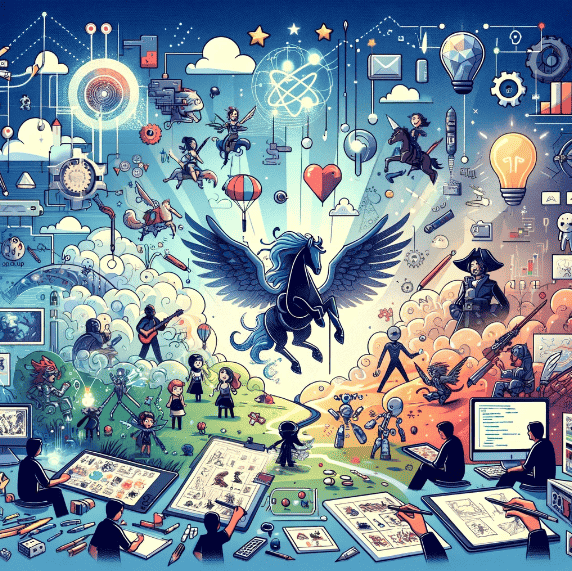
In an era where digital landscapes offer limitless possibilities, the art of game design stands as a testament to human creativity and technological advancement. This ever-evolving field combines the brilliance of narrative storytelling, the aesthetics of visual arts, and the intricacies of software engineering to create interactive experiences unlike any other medium. Today, game designers are not just creators of entertainment; they are architects of complex worlds, weavers of rich narratives, and innovators pushing the boundaries of what digital spaces can achieve.
The process of crafting these worlds and stories within digital spaces is a meticulous and multi-layered journey. It begins with the seed of an idea, often drawn from a myriad of inspirations – literature, film, history, or even real-world events. This idea then blossoms through collaborative efforts, involving writers, artists, programmers, and sound designers, each contributing their unique skills to bring the game to life.
Understanding the Core of Game Design
At the heart of every great game is a strong design principle. It involves more than just technical expertise; it requires a deep understanding of what makes a game engaging. This includes the mechanics of gameplay, the structure of levels, and the challenge-reward system that keeps players hooked. For instance, consider the precision required in balancing difficulty levels to ensure a satisfying but not frustrating experience. A game designer must also contemplate the pacing of the game – how the narrative unfolds and how players progress through different stages. A well-paced game can keep players engrossed for hours, while a poorly structured one might lose their interest quickly. Additionally, game designers often utilize elements like power-ups, hidden secrets, and branching storylines to add depth and replayability to their games. This intricate layering of elements ensures that each playthrough can offer a new experience, catering to a wide range of players, from casual enthusiasts to hardcore gamers.
Visual and Audio Elements: Bringing the Game World to Life
Visuals and audio play a crucial role in game design. They set the tone, create the atmosphere, and can even guide gameplay. The choice of colors, the design of characters and environments, and the music and sound effects all contribute to the overall experience. Just like how subtle tweaks such as how to make folders different colors on mac, as explained in this insightful guide, can significantly improve user experience, the visual and audio aspects of a game can profoundly impact the player’s immersion and emotional connection.
When it comes to visuals, it’s not just about high-resolution textures or realistic models; it’s about creating a cohesive visual language that supports the game’s narrative and gameplay. Color schemes can evoke specific emotions or denote different factions or areas in the game world. The design of characters and environments is crucial in building a believable and engaging world. Whether it’s a dystopian future city or a fantasy forest, every visual element must align with the game’s theme and story.
The Role of Narrative in Enriching Gameplay
Storytelling in games is not just an add-on; it’s a vital component that can elevate the gaming experience. A well-crafted narrative can immerse players in the game world, making their actions feel impactful and meaningful. Through narrative, games can evoke emotions, present moral dilemmas, and even comment on real-world issues, much like a captivating novel or a thought-provoking film. The integration of story elements with gameplay mechanics is a delicate art. It requires a balance that doesn’t overwhelm the player but rather complements the gaming experience. For example, narrative-driven games might use character development and plot twists to engage players, while others might use environmental storytelling to subtly convey the lore of the game world. The best game narratives are those that remain memorable long after the game is over, leaving a lasting impact on the player.
The Evolution of Gaming Technology
The advancements in gaming technology have opened new horizons for designers. From the early days of pixelated 2D graphics to the current era of virtual reality and AI-driven NPCs, technology has continuously pushed the boundaries of what’s possible in game design. This evolution not only changes how games are made but also expands the ways in which stories are told and worlds are built. With each technological leap, game designers have new tools at their disposal to create more realistic, immersive, and interactive experiences. The introduction of 3D graphics allowed for more dynamic and complex environments, while online connectivity brought players together from around the world. More recently, VR and AR technologies have begun to blur the lines between the digital and physical worlds, offering even more immersive experiences. These technological advancements not only enhance the visual and auditory experience but also open up new gameplay possibilities, allowing designers to experiment with innovative concepts that were previously impossible.
Player Engagement and Interaction: The Ultimate Goal
Engaging the player is the ultimate goal of game design. This can be achieved through various means: compelling storytelling, intuitive gameplay, rewarding challenges, and immersive worlds. Designers must constantly think about how to keep players engaged and invested in the game. Whether it’s through multiplayer interactions, replayability, or simply a captivating story, player engagement is the key to a game’s success. This engagement goes beyond just keeping the player entertained; it’s about creating a connection between the player and the game. Effective game design can foster a sense of achievement, belonging, and even emotional attachment. Multiplayer games, for instance, build communities and camaraderie among players, while single-player games can offer deep, personal experiences that resonate on an individual level. The challenge for game designers is to understand their audience and craft experiences that can appeal to a wide range of players, each with their own preferences and play styles.
Conclusion: The Future of Game Design
As we look to the future, the possibilities in game design are as vast as the digital worlds they create. The questions raised by the evolving nature of game design are numerous: How will emerging technologies like augmented reality change the way we play? Can games become a more influential medium for storytelling? The answers lie in the continuous innovation and creativity of game designers. By pushing the limits of technology, narrative, and player engagement, they are not just creating games; they are crafting experiences that resonate with players on a profound level.
In this digital era, the art of game design is more than just a form of entertainment; it’s a medium that combines technology, storytelling, and artistic expression in unique and powerful ways. As players and enthusiasts, we have much to look forward to as we continue to explore these incredible digital worlds and stories.





